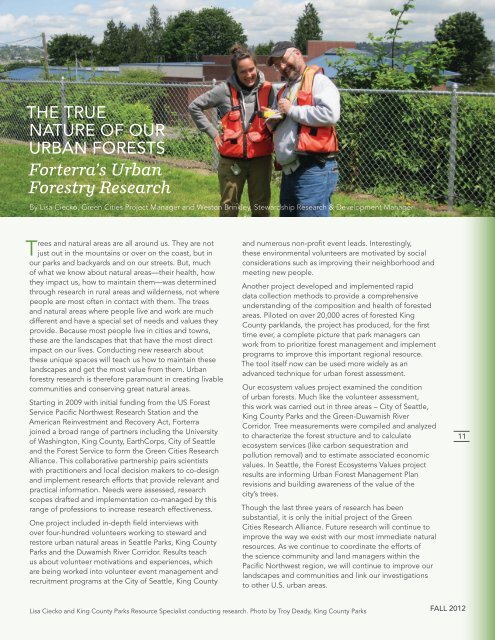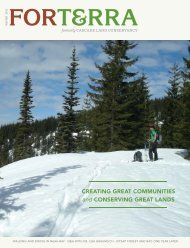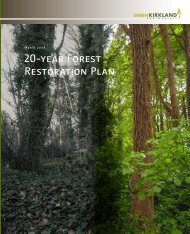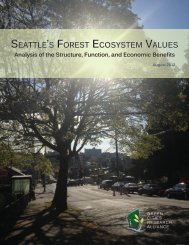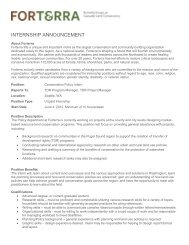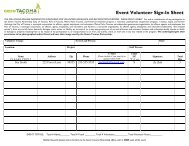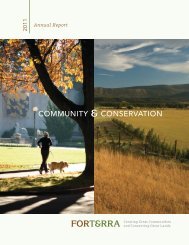Download - Cascade Land Conservancy
Download - Cascade Land Conservancy
Download - Cascade Land Conservancy
Create successful ePaper yourself
Turn your PDF publications into a flip-book with our unique Google optimized e-Paper software.
THE TRUE<br />
NATURE OF OUR<br />
URBAN FORESTS<br />
Forterra’s Urban<br />
Forestry Research<br />
By Lisa Ciecko, Green Cities Project Manager and Weston Brinkley, Stewardship Research & Development Manager<br />
Trees and natural areas are all around us. They are not<br />
just out in the mountains or over on the coast, but in<br />
our parks and backyards and on our streets. But, much<br />
of what we know about natural areas—their health, how<br />
they impact us, how to maintain them—was determined<br />
through research in rural areas and wilderness, not where<br />
people are most often in contact with them. The trees<br />
and natural areas where people live and work are much<br />
different and have a special set of needs and values they<br />
provide. Because most people live in cities and towns,<br />
these are the landscapes that that have the most direct<br />
impact on our lives. Conducting new research about<br />
these unique spaces will teach us how to maintain these<br />
landscapes and get the most value from them. Urban<br />
forestry research is therefore paramount in creating livable<br />
communities and conserving great natural areas.<br />
Starting in 2009 with initial funding from the US Forest<br />
Service Pacific Northwest Research Station and the<br />
American Reinvestment and Recovery Act, Forterra<br />
joined a broad range of partners including the University<br />
of Washington, King County, EarthCorps, City of Seattle<br />
and the Forest Service to form the Green Cities Research<br />
Alliance. This collaborative partnership pairs scientists<br />
with practitioners and local decision makers to co-design<br />
and implement research efforts that provide relevant and<br />
practical information. Needs were assessed, research<br />
scopes drafted and implementation co-managed by this<br />
range of professions to increase research effectiveness.<br />
One project included in-depth field interviews with<br />
over four-hundred volunteers working to steward and<br />
restore urban natural areas in Seattle Parks, King County<br />
Parks and the Duwamish River Corridor. Results teach<br />
us about volunteer motivations and experiences, which<br />
are being worked into volunteer event management and<br />
recruitment programs at the City of Seattle, King County<br />
and numerous non-profit event leads. Interestingly,<br />
these environmental volunteers are motivated by social<br />
considerations such as improving their neighborhood and<br />
meeting new people.<br />
Another project developed and implemented rapid<br />
data collection methods to provide a comprehensive<br />
understanding of the composition and health of forested<br />
areas. Piloted on over 20,000 acres of forested King<br />
County parklands, the project has produced, for the first<br />
time ever, a complete picture that park managers can<br />
work from to prioritize forest management and implement<br />
programs to improve this important regional resource.<br />
The tool itself now can be used more widely as an<br />
advanced technique for urban forest assessment.<br />
Our ecosystem values project examined the condition<br />
of urban forests. Much like the volunteer assessment,<br />
this work was carried out in three areas – City of Seattle,<br />
King County Parks and the Green-Duwamish River<br />
Corridor. Tree measurements were compiled and analyzed<br />
to characterize the forest structure and to calculate<br />
ecosystem services (like carbon sequestration and<br />
pollution removal) and to estimate associated economic<br />
values. In Seattle, the Forest Ecosystems Values project<br />
results are informing Urban Forest Management Plan<br />
revisions and building awareness of the value of the<br />
city’s trees.<br />
Though the last three years of research has been<br />
substantial, it is only the initial project of the Green<br />
Cities Research Alliance. Future research will continue to<br />
improve the way we exist with our most immediate natural<br />
resources. As we continue to coordinate the efforts of<br />
the science community and land managers within the<br />
Pacific Northwest region, we will continue to improve our<br />
landscapes and communities and link our investigations<br />
to other U.S. urban areas.<br />
11<br />
Lisa Ciecko and King County Parks Resource Specialist conducting research. Photo by Troy Deady, King County Parks<br />
FALL 2012


